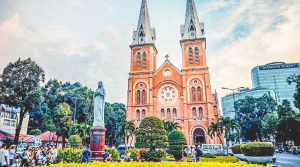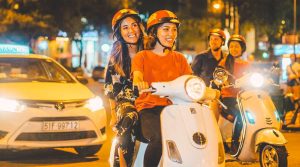When planning your trip, these Vietnam travel tips will help you make the most of your journey. Our insights come from both seasoned locals and experienced expatriates who understand the needs and preferences of foreign travelers. While many tips online are from people who have visited Vietnam only once or twice, or from locals who might not fully grasp the needs of international tourists, our tips offer a well-rounded perspective to ensure your trip is unforgettable.
These are the absolute best Vietnam travel tips you can find. We divided them into three categories:
- Travel tips for planning your trip to Vietnam: Essential advice for choosing destinations, booking flights, and deciding on accommodations.
- Vietnam travel tips: What to prepare before you go: Practical tips on visas, packing, and essential items to bring.
- Travel tips while traveling in Vietnam: Insider advice on cultural etiquette, transportation, and staying safe during your trip.
Tip: Download our free eBook
Before diving into the specific tips, we recommend downloading our free ebook. This comprehensive guide is packed with over 200 pages of travel tips, including what to prepare, example routes based on the length of your stay, inspiration, destination guides, transportation advice, cultural tips, and much more. Best of all, it’s completely free.
Travel tips for planning your trip to Vietnam
Planning your trip to Vietnam can be overwhelming with so many incredible places to visit and things to do. These tips will help you plan your itinerary, get inspired on where to go, and book your flights and accommodations efficiently.
1. Don’t try to see everything
2. Best time to visit Vietnam
3. Best things to do in Vietnam based on your interest
4. Start in Ho Chi Minh City or Hanoi?
5. Booking your flights to Vietnam
6. Booking accommodations
7. Getting around Vietnam: booking domestic flights, trains and buses
1. Don’t try to see everything
One of the best Vietnam travel tips is to avoid trying to see everything in one trip. Vietnam is a vast country with countless sights and experiences. It might be tempting to fit in as much as possible, but this can make your trip feel rushed and overwhelming. The country’s winding roads, mountain passes, and slow trains mean travel times can be lengthy. Therefore, it’s best to select destinations that fit the time you have. Here’s a guide to help you plan:
- 1 Week: Focus on one region. We highly recommend Northern Vietnam, where you can explore Hanoi, Halong Bay, and Sapa.
- 2 Weeks: Either focus on one region or split between two regions. For instance, you could explore Northern Vietnam and Central Vietnam, visiting places like Hue and Hoi An along with Hanoi, Sapa and Ha Long Bay.
- 3 Weeks: Explore two or all three regions. A popular choice is to combine Northern and Central Vietnam.
- 4 Weeks: You can comfortably explore all three regions: Northern, Central, and Southern Vietnam.
2. Best time to visit Vietnam
One of the most frequently asked questions is: “What is the best time to visit Vietnam?” Understandably, weather can greatly affect the experience of your trip. Vietnam is a long country stretching from north to south, and it has different weather regions, each with its own best travel time:
- North Vietnam: Best from October to April, but summer is the only time to see the rice fields in full bloom.
- Central Vietnam: Best from February to August.
- South Vietnam: Best from November to April.
Overall best time for whole Vietnam: February – April. If you prefer cooler weather and less humidity, visiting in the winter months might be ideal, while summer travelers can enjoy the best landscapes.
Read here our full guide about: best time to visit Vietnam.
3. Best things to do in Vietnam based on your interest
Everyone has different travel styles and interests, so there isn’t one definitive list of the best things to do in Vietnam. To help you plan your itinerary, we have created several lists based on specific interests. These lists will guide you to the destinations that suit your preferences:
- Best cultural experiences in Vietnam
- Unique food experiences in Vietnam
- Most beautiful beaches in Vietnam
- Most beautiful rice fields in Vietnam
- Top adventure activities in Vietnam
- Top off the beaten track destinations
- Best places for trekking in Vietnam

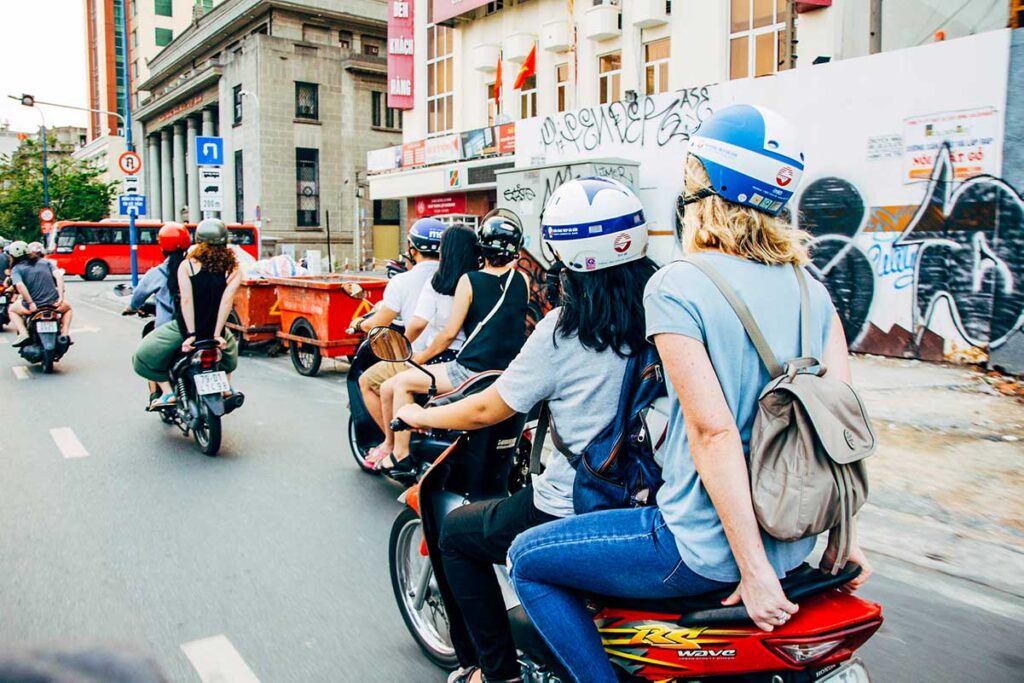
4. Start in Ho Chi Minh City or Hanoi?
Choosing between starting your trip in Ho Chi Minh City or Hanoi depends on several factors, including flight costs, travel plans, and personal preferences. Here’s a breakdown to help you decide:
Flight costs and multi-destination tickets: Check for multi-destination tickets (e.g., flying into Hanoi and out of Ho Chi Minh City) and compare costs to find the cheapest option.
Why start in Ho Chi Minh City:
- If you only want to visit Southern Vietnam.
- Has the most flights and better connectivity.
- Softer cultural landing, as the city is more Westernized.
- Traveling from south to north means the scenery will get better and more rewarding as you go.
Why start in Hanoi:
- If you only want to visit Northern Vietnam.
- Newer and less chaotic airport with shorter queues and quicker security checks.
Tip: If booking with Local Vietnam, consider flying into Hanoi, as our expert team is based there.
5. Booking your flights to Vietnam
Vietnam doesn’t have a major flight hub, so flights often include a transit. Here are some tips:
- Avoid long transits: Ensure your transits aren’t too long to avoid excessive travel fatigue.
- Book in advanced: Book flights well in advance for high season; three months in advance is good for low season.
- Use flight comparison websites: Compare prices from multiple airlines and booking platforms (e.g., Skyscanner, Google Flights) to find the best deals.
- Price alert: Use price alerts on Skyscanner to monitor fare changes and secure the best deals.
- Best time of the week: Consider booking flights on weekdays for better prices.
- Be flexible with dates and times: Consider flying on weekdays or during off-peak hours for potentially lower fares.

6. Booking accommodations
When it comes to travel tips for Vietnam, booking accommodations is an important aspect to consider. The right place to stay can greatly enhance your trip, while a poor choice can really make your trip less enyoable. Here are some specific tips to help you make the best choices for your Vietnam trip:
Location, location, location: Don’t book your stay outside the tourist areas just to save money. The lack of public transportation means you will spend more on taxis. Central locations in cities like Hanoi and Ho Chi Minh City offer better access to attractions and dining options. In places like Sapa and Ninh Binh, choose accommodations in the countryside, preferable with stunning views, instead of staying in the main towns.
Hotel rooms with no windows: Be aware that some hotels in Hanoi and Ho Chi Minh City have rooms without windows. This is due to narrow, deep plots where only the rooms at the front have windows. Always check room descriptions and reviews before booking.
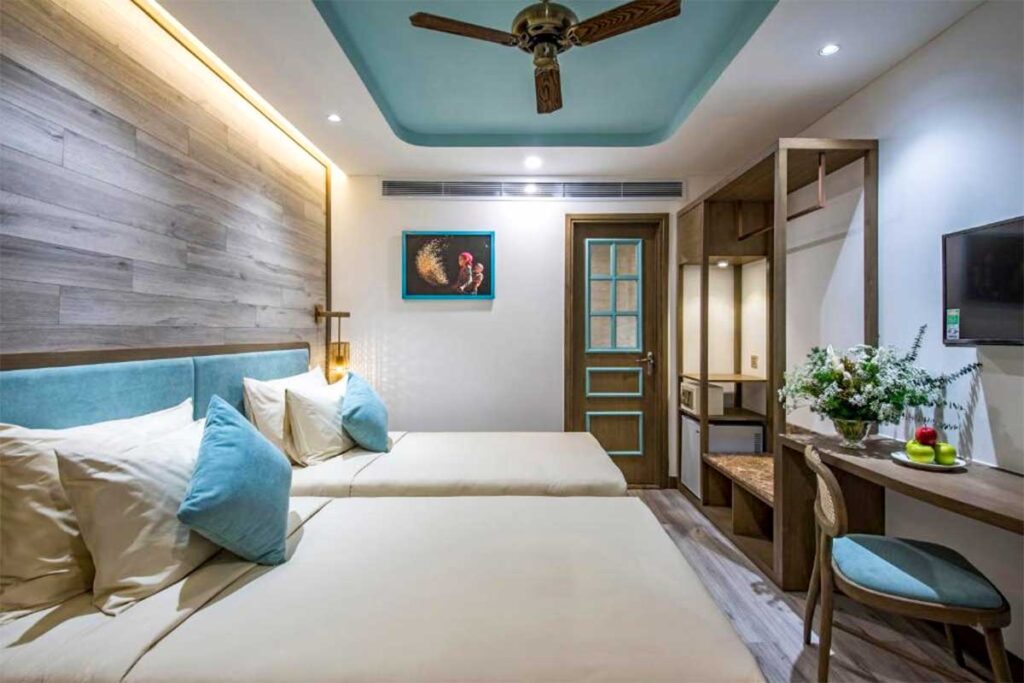
Stay overnight in an ethnic homestay: For a genuine local experience, consider staying in an ethnic homestay. These are basic but offer an authentic cultural experience, including family dinners and insights into local life. Since most authentic homestays are not listed online, consulting a local travel agent can help you find the best options.
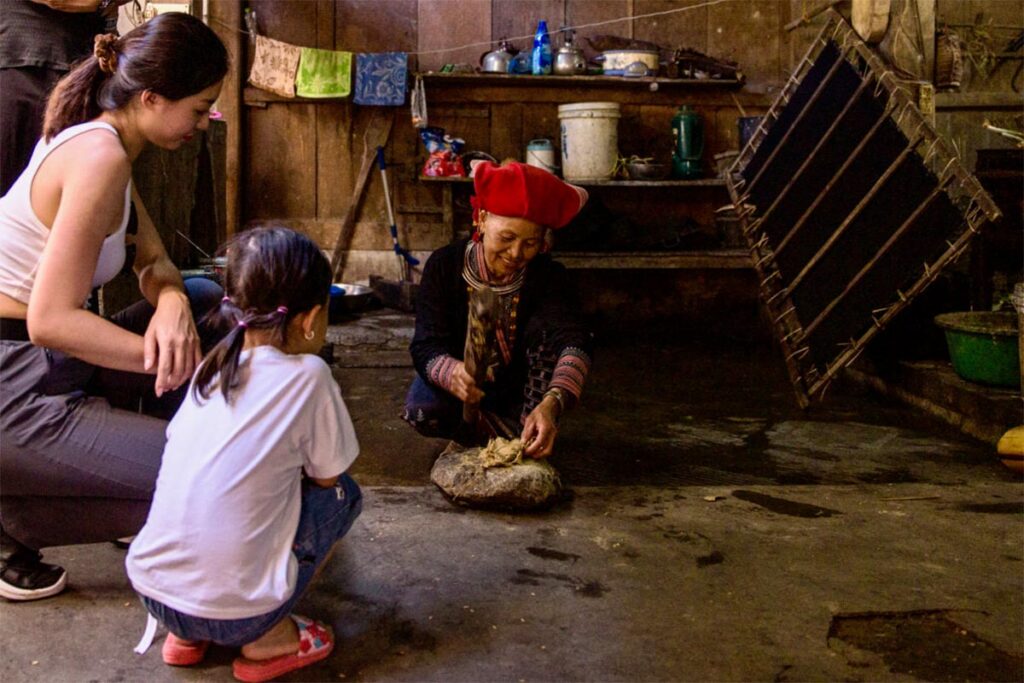
Book in advance for peak season: During popular travel times, especially in tourist hotspots, it’s wise to secure your accommodations early to avoid disappointment and higher prices.
7. Getting around Vietnam: booking domestic flights, trains and buses
Traveling around Vietnam can be done efficiently using domestic flights, trains, and buses. Each option has its own advantages and best use cases:
Domestic flights
Vietnam has many airports, but not all are connected directly to each other. However, most are connected to Ho Chi Minh City (HCMC) and Hanoi. Domestic flights are a great alternative to long, tiring bus trips, saving you time and offering a safer travel option. Prices are very affordable, with flights starting from as low as $35. Vietnam Airlines is the best option for service and reliability, while VietJet Airways offers the best ticket deals despite its reputation for delays.
- Best site to book domestic flights: Traveloka
Buses
Buses in Vietnam connect to every corner of the country, making them a super cheap option for travel. However, not everyone feels safe on buses, especially the ones that drive at night. Limousine vans are a better option as they travel during the day, are comfortable, and also inexpensive.
- Best site to book buses in Vietnam: Vexere
Train travel
Trains are more expensive than buses but often cheaper than flights. They are a very safe travel option, although they only connect cities along the coast and to Sapa. The train journey is unique, as it travels through towns on old tracks, making it quite bumpy and slow.
Bonus tip: Travel at night to save time
Night buses are the cheapest option, but they may not be the most comfortable or safest for everyone. Night trains are a safe alternative for overnight travel.
Vietnam travel tips: what to prepare before you go
Planning and preparation are key to ensuring a smooth and enjoyable trip to Vietnam. Here are essential tips for what to prepare before you go:
8. Apply of your e-visa as soon as possible
9. Download these apps
10. Backpack or suitcase?
11. What clothes to bring
12. Healthcare traveling tips for Vietnam
13. Bringing travel adapters
14. Get travel Insurance
8. Apply of your e-visa as soon as possible
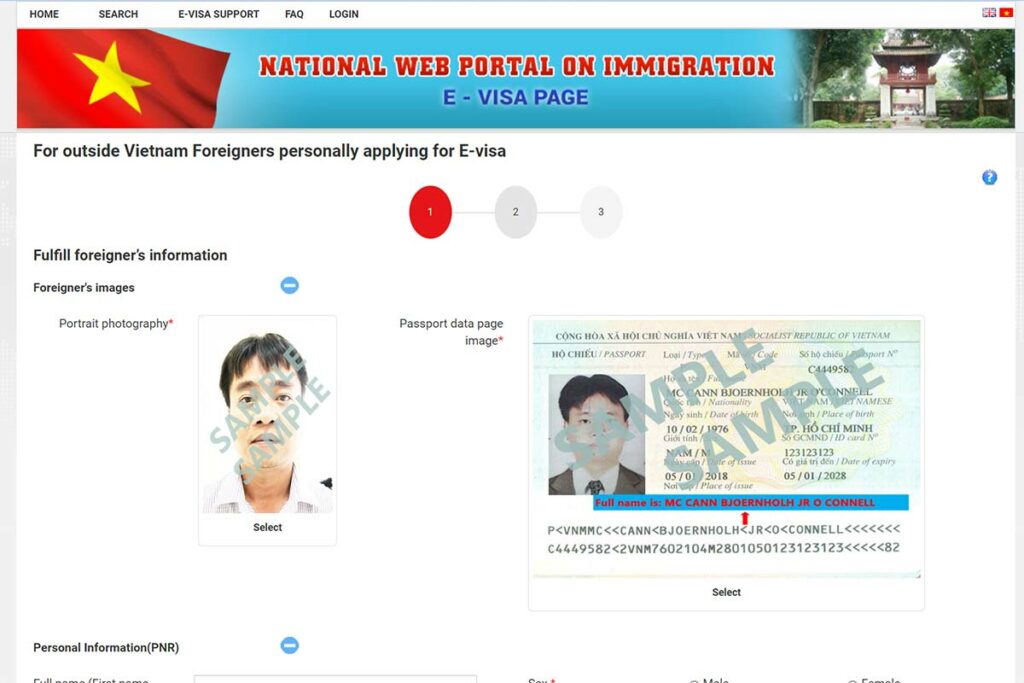
One of the most important travel tips for Vietnam is to apply for your e-visa well in advance. We frequently receive emergency visa requests from travelers who didn’t know they needed one or forgot to apply on time. Citizens from most countries, including the US, Australia, and Canada, need to arrange a visa before traveling. Without a visa, you won’t be allowed to board your plane to Vietnam. You can apply for an e-visa on the official website of the Vietnamese immigration service. It costs $25 for a single entry and can be applied for up to 90 days in advance.
To avoid any mistakes in the application, you can read our guide how to apply for a Vietnam e-visa.
9. Download these apps
Having the right apps can make your trip to Vietnam much smoother:
- Grab: The biggest ride-hailing app in Vietnam, Grab allows you to book taxis, motorbike taxis, and food delivery. It’s reliable and easy to use, providing a convenient way to get around and order meals.
- TripAdvisor: This app is great for researching restaurants, hotels, and activities. It provides reviews and ratings from other travelers, helping you make informed decisions about where to eat, stay, and what to do.
- XE Currency Converter: This app helps you quickly convert currencies and keep track of exchange rates. It’s especially useful for budgeting and making sure you’re getting a fair deal.
Important tip for Google Translate and Google Maps! Consider downloading offline data for Google Maps and Google Translate. This can be incredibly helpful if you find yourself without internet access.
Read here more about useful travel apps in Vietnam.
10. Backpack or suitcase?
Deciding whether to bring a backpack or a suitcase depends on your travel style and budget. Here are some considerations:
- Backpack: If you’re on a tight budget, a backpack is more convenient. Sidewalks in Vietnam are often uneven and crowded with motorbikes and street vendors, making wheeled suitcases difficult to manage. A backpack allows for easier movement and flexibility, especially if you plan to travel to remote or rural areas.
- Suitcase: If you have a slightly higher budget, a suitcase can be a viable option. Many bus services include hotel pick-up, and taxis are very cheap, allowing for door-to-door travel without much hassle.
11. What clothes to bring
The best travel tip for Vietnam regarding packing is not to bring too much. Remember that you’ll be carrying everything with you all the time. If you really miss something, don’t worry—Vietnam is very cheap, and you can buy clothes, jackets, and shoes here for a fraction of the price at home. While they might not always be real brands, the quality is often very good.
When packing for Vietnam, it’s best to dress in layers to accommodate the varying weather conditions:
- Wear Layers: This allows you to adjust your clothing based on the weather and your activities. Layers are versatile and can be added or removed as needed.
- Light Jacket: A wind/rain jacket is essential for the summer months when rain is common, and it’s also useful in the cooler winter months. Look for a jacket that is easy to fold and pack.
- No Hiking Boots: Unless you plan on extensive trekking, avoid bringing heavy hiking boots. Instead, bring good walking shoes that are comfortable for various activities. Lightweight, breathable footwear is ideal for the majority of your trip.
Before you pack too many clothes, also read our tip about laundry services in Vietnam.
12. Healthcare travel tips for Vietnam
Staying healthy while traveling in Vietnam is crucial. Here are some tips:
Mosquito protection: Mosquitoes can be a nuisance in Vietnam, especially in rural and jungle areas. Use mosquito/insect spray to protect yourself. There is no need to bring your own mosquito net, as accommodations in areas with many mosquitoes usually provide them.
Vaccinations: It is recommended to get vaccinations for Hepatitis A, Hepatitis B, Typhoid, and Japanese Encephalitis.
Extra Tip: Best to consult your own personal doctor or health professional for advice on this matter. They can provide recommendations based on your health history and travel plans.
13. Bringing travel adapters
A key travel tip for Vietnam is to ensure you have the right travel adapters for your electronics:

Sockets used: Vietnam primarily uses Type A (two flat pins) and Type C and F (two round pins) sockets.
- A few countries that do NOT need adapters: Travelers from Japan and the United States (Type A) will generally not need adapters.
- Popular countries that DO need adapters: Travelers from the United Kingdom (Type G) and Australia (Type I) will need adapters to use their devices in Vietnam.
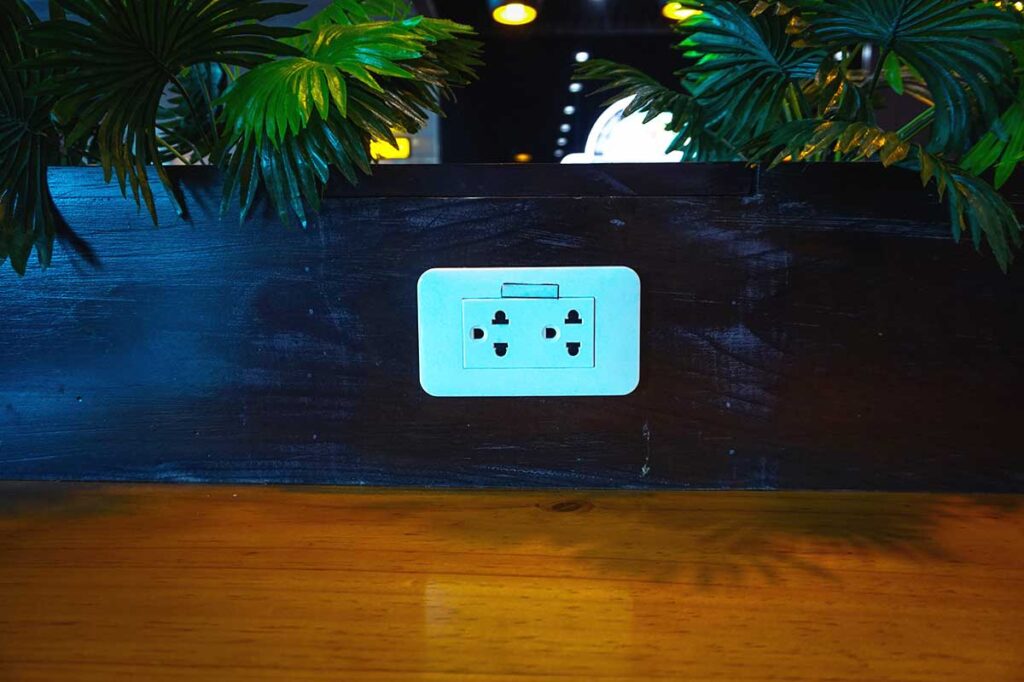
14. Get travel insurance
Having travel insurance before your trip is essential. It provides peace of mind knowing you’re covered for various potential issues, from health emergencies to trip cancellations. Without it, even minor incidents can lead to significant expenses and stress, making your trip less enjoyable.
- Motorbike coverage: If you plan to drive a motorbike in Vietnam, make sure you are covered by your insurance. Most policies require you to have a motorbike license and a valid International Driving Permit (IDP). Without these, you might not be covered in case of an accident. Verify the details of your policy to avoid any issues during your trip.
Travel tips while traveling in Vietnam
This section provides practical tips to help you navigate and enjoy your time in Vietnam. From getting connected to finding convenient services and staying safe, these tips are designed to make your travel experience smoother and more enjoyable.
15. Buying a local sim card
16. Make use of laundry services
17. Cash is king in Vietnam
18. Using coffee shops for a toilet break
19. Getting around town with taxi apps
20. These are the best buses in Vietnam
21. Tips for traveling by train in Vietnam
22. Be careful in traffic
23. Try local food and how to find the best place
24. Cultural do’s & don’ts
25. To flush or not to flush
15. Buying a local sim card
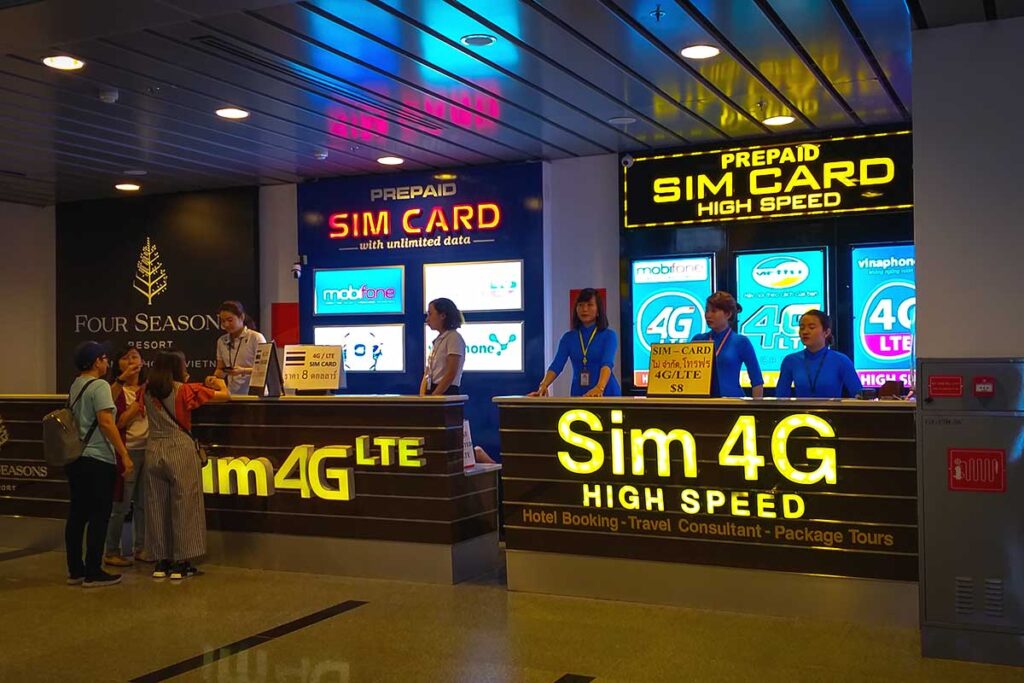
One of the first things you should do when arriving in Vietnam is buying a Vietnamese SIM card. It is perhaps the best Vietnam travel tip there is. With a local SIM, you have internet access everywhere and anytime during your trip. This will help you navigate, translate, research what to do, read reviews of restaurants, and keep in contact with your friends and family back home.
Additional tip: When you book a package trip with us, we provide a free Vietnamese SIM card on arrival, so you can always stay in contact with us during your trip for questions and help.
16. Make use of laundry services
Continuing from one of the the previous Vietnam travel tips about what clothes to bring, here is an even better tip! During your trip, you will use a lot of clothes. The hot weather makes you want to change clothes more often, and the same goes for activities, even in winter. You would need a huge suitcase to fit enough clothes for your entire trip. Instead, take advantage of the local laundry services.
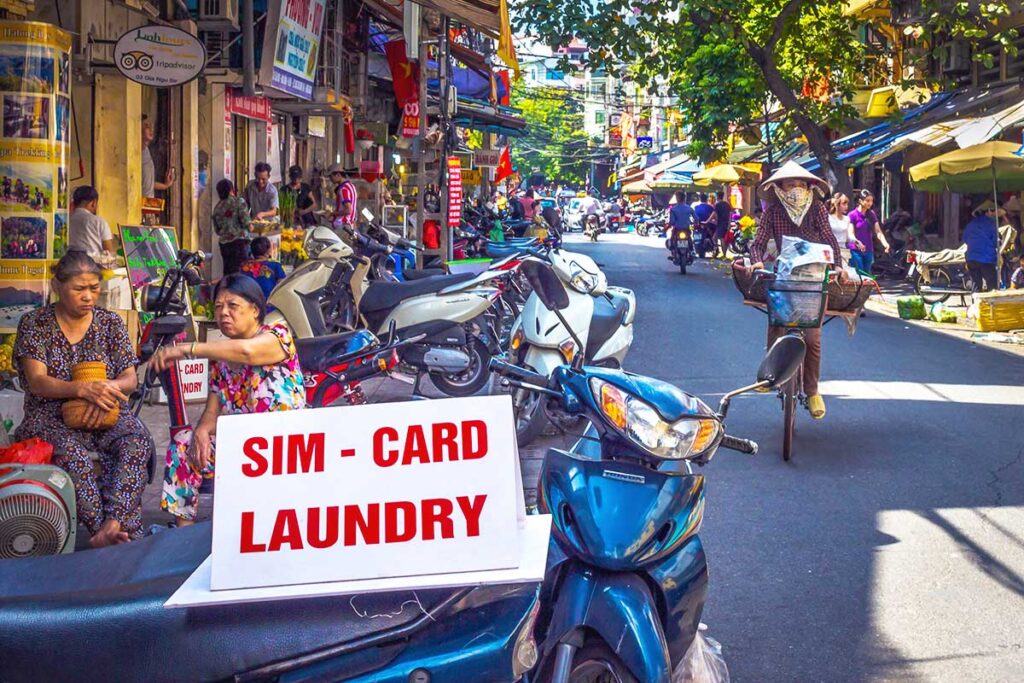
In Vietnam, you can find laundry services almost everywhere. They will wash, dry, and neatly fold your clothes for you, typically within 24 hours. They often have an express service as well. The price is less than 1 USD per kilo of laundry.
17. Cash is king in Vietnam
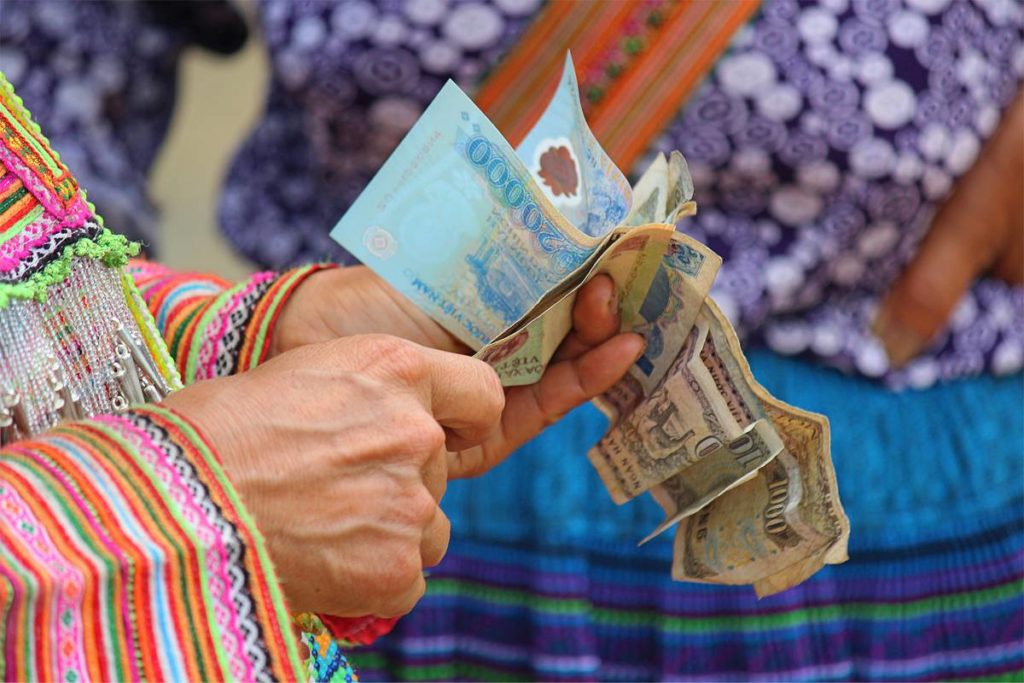
When dining at local restaurants, buying bus tickets, staying in homestays, or shopping for souvenirs, you’ll often need to pay with cash. While larger hotels and modern restaurants may accept credit cards, most local shops and restaurants do not. Therefore, make sure you always have enough cash on hand, especially if you plan to travel to the countryside where there are no ATMs.
18. Using coffee shops for a toilet break
This is another great insider Vietnam travel tip that! Public toilets are scarce in Vietnam, but this is far from a problem. No matter where you are, you can easily find a coffee shop. Especially in tourist centers, streets are filled with them. They sell drinks like coffee, tea, and fresh juices starting from 0.50 USD. For the purchase of a drink, you are welcome to use their toilet too.
19. Getting around town with taxi apps
Taxi apps are a convenient way to get around town in Vietnam. These apps allow you to book rides easily and often at lower prices than standard taxis. They also provide more security and transparency regarding fares, as you see the price upfront. Grab is the most popular app for booking taxis and motorbike taxis.
Steps to use taxi apps:
- Download and install the app from the App Store or Google Play.
- Register and set up your account.
- Enter your pick up and drop off destinations and choose your ride type (car, motorbike, etc.).
- Confirm your booking and wait for your driver.
20. These are the best buses in Vietnam
Sleeper buses:
- Sleeper buses are primarily used for long distances and usually operate at night. They have reclining seats that allow you to lie down. Popular routes include Ho Chi Minh City to Dalat and Da Nang to Ninh Binh, Hanoi to Ha Giang and Hanoi to Sapa.
- Night travel saves daytime for exploring and the cost of accommodation, but not everyone can sleep well on buses, and there are safety concerns. Prices for these buses are around 10-25 USD.
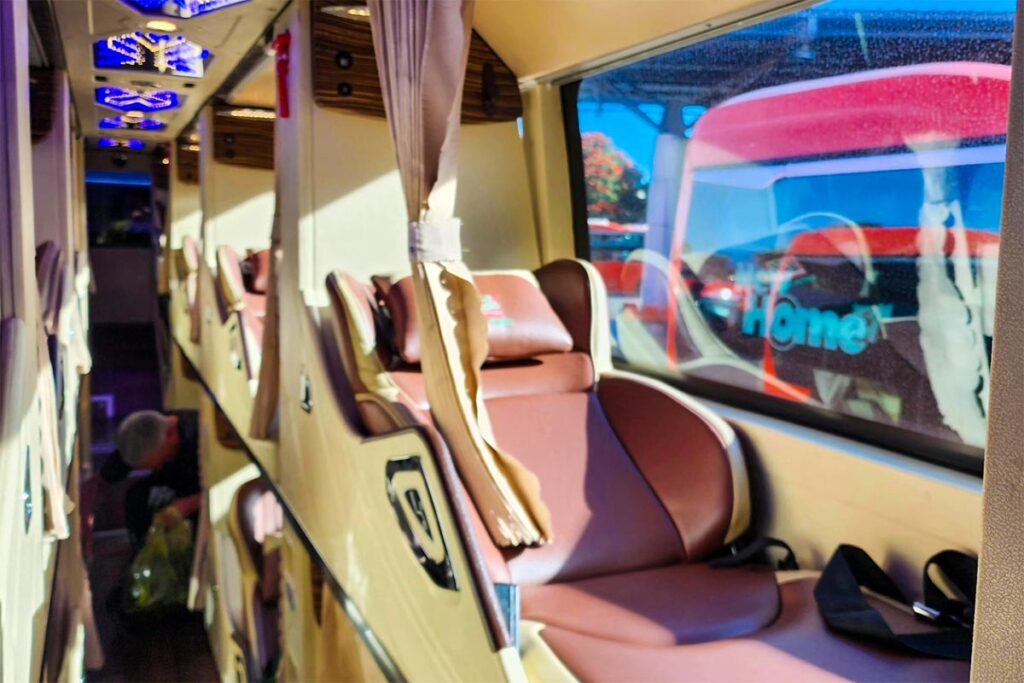
Our tip: Try to avoid regular sleeper buses. If you have to use one, opt for VIP sleeper buses, which offer almost double the space and more privacy. Also, bring noise-canceling headphones.

Limousine buses:
- Limousine buses are shared vans that are more comfortable than regular buses and even cars. They are often priced between 15 to 25 USD for trips longer than five hours. These buses operate during the day and feel safer than sleeper buses at night. However, they might take up some valuable daytime if you have a busy itinerary.

21. Tips for traveling by train in Vietnam
Train travel in Vietnam is safer than bus travel, but the trains are slow due to old tracks and routes that go through towns. Here are some tips:
- Pick the right class: For longer trips, always book the 4-berth sleeper cabins. There are also 6-berth and soft/hard seat options, but they are less comfortable. The 4-berth cabins offer more comfort and privacy.
- Book all seats for more privacy: If you are traveling with another person, consider booking all four berths in the cabin. This way, you don’t have to share with strangers, providing more privacy and security for your luggage.
- Book tourist trains: On popular routes like Hanoi to Sapa, there are tourist trains with nicer cabins and better-maintained facilities.
- What to bring: Noise-canceling headphones for the noise, snacks since the options on the train are limited, and hygiene products for toilet use.

22. Be careful in traffic
Vietnam is a very safe country with low crime rates against foreigners. However, you need to be cautious in traffic. Here are some Vietnam travel tips regarding traffic:
When crossing the street: Make yourself visible and walk at a steady pace so that drivers can predict your movements. Never run across the street.

Riding a scooter: Carefully consider whether riding a scooter is right for you. If you have little experience or do not feel comfortable, it is better not to ride one yourself. Safety comes first, and there are plenty of other ways to get around without taking unnecessary risks.
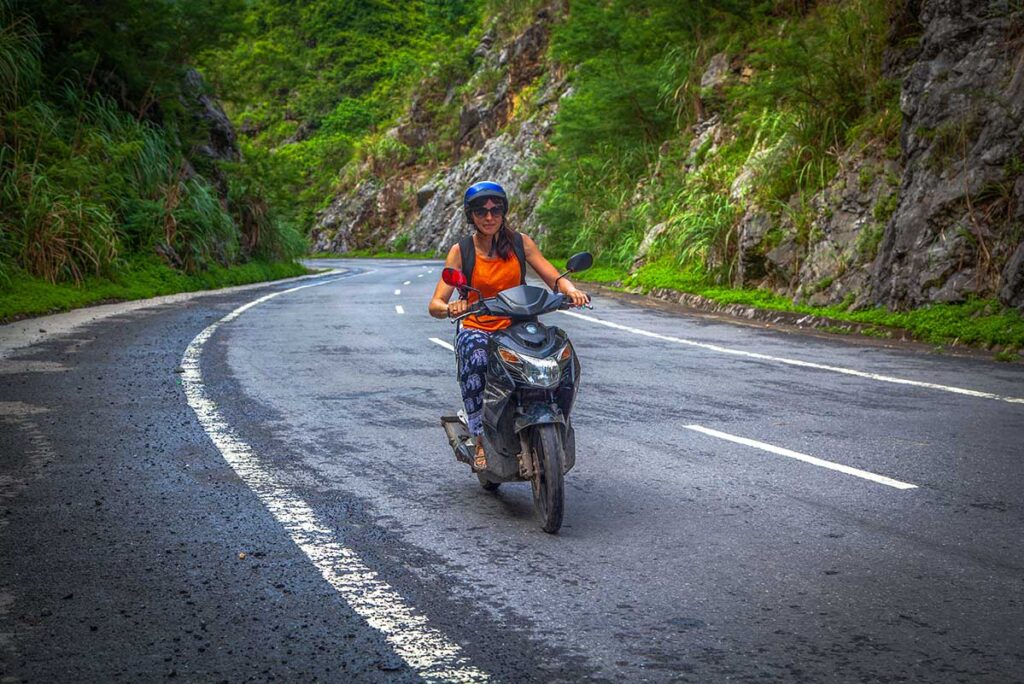
23. Try local food and how to find the best place
One of the essential Vietnam travel tips is to explore the local cuisine, which is rich and diverse, reflecting the country’s culture and history. Trying local food is a highlight of any trip to Vietnam. Here are some tips to help you pick the best places to eat:
- Check reviews online: Use apps like TripAdvisor or Google Reviews to find highly-rated local restaurants. Look for places with a lot of positive feedback from other travelers.
- Observe the crowd: For street food, choose stalls that have a lot of locals ordering. This indicates that the food is fresh and tasty, as high turnover means the food isn’t sitting around all day.
- Inspect cleanliness: Ensure that the place looks clean and the food is prepared in a hygienic manner. This can help you avoid foodborne illnesses.
- Ask for recommendations: Don’t hesitate to ask locals for their favorite spots. They often know the best places that might not be listed online.
- Join a food tour: A food tour with a local guide can be an excellent way to discover the best eateries and gain cultural insights. Guides can take you to hidden gems and explain the history and significance of the dishes you try.
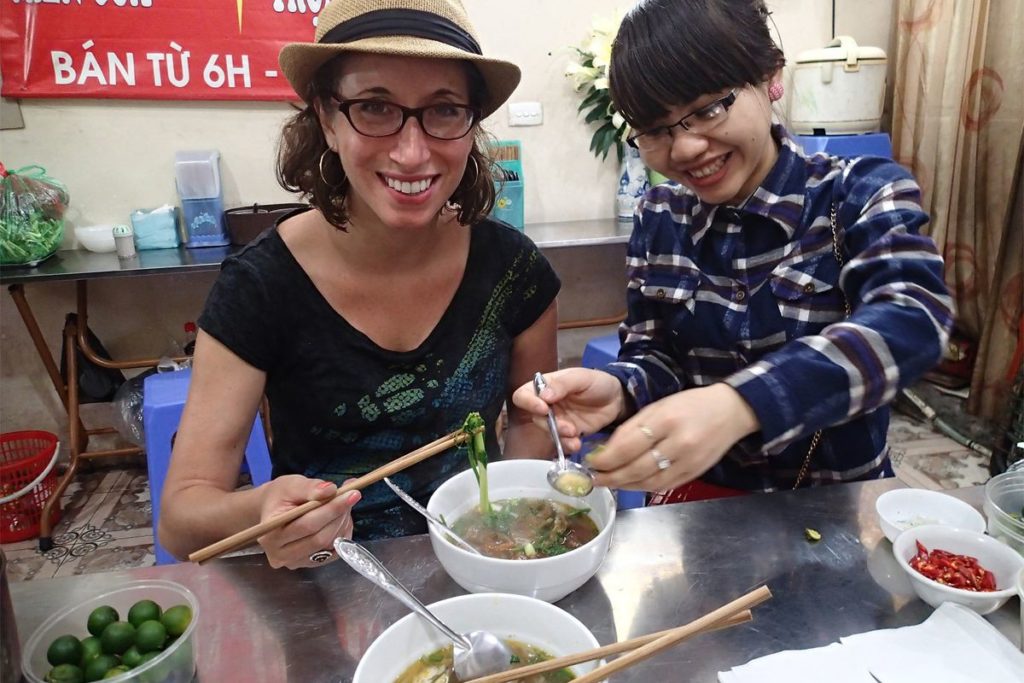
24. Cultural do’s & don’ts
Vietnamese culture is deeply rooted in traditions and customs. Respecting these can enhance your experience and interactions with locals. Here are some cultural do’s and don’ts:
- Do greet with a smile and slight bow.
- Do dress modestly, especially when visiting temples and pagodas.
- Do remove your shoes before entering someone’s home.
- Don’t take photos of people without their permission.
- Don’t lose your temper in public; it’s considered very disrespectful.
- Don’t show public displays of affection.
25. To flush or not to flush
Toilets in Vietnam can vary, and a common question is whether you can flush toilet paper. Here are some guidelines:
- In many places, especially rural areas and older buildings, plumbing systems are not designed to handle toilet paper. Instead, there will be a bin next to the toilet for disposal.
- In more modern resorts and establishments, it’s usually safe to flush toilet paper. Always check for signs or ask if you’re unsure.
Personal travel tips for Vietnam
There are so many more Vietnam travel tips we can provide. Some tips are more personalized, depending on your travel style, the time you travel, or even your individual needs. Whether you need advice on traveling with a disability, managing an allergy, navigating the rainy season, or recommendations for specific locations, we have you covered. Here’s a small overview of some of the most common personal tips people are looking for.
- Traveling with allergies
- Traveling with a disability
- Traveling during rainy season
- Traveling with kids
- Traveling as a solo female traveler
Still looking for more information about something specific? Either browse our website or join our community on Facebook, where our experts are very active in answering all your questions.
Our best Vietnam travel tip
Planning a trip to Vietnam can be overwhelming with so much to take in, plan, and organize. From finding the best places to visit, booking accommodations, and connecting destinations with transfers, it can be a lot to manage. That’s where we come in. Our best Vietnam travel tip is to use our service for a stress-free travel experience.
We offer peace of mind with our extensive experience and local experts based in Vietnam. We can arrange everything for you. Just let us know your wishes, and we will tailor-make a trip completely based on your preferences. Request a free trip plan, and we will send you an itinerary within 1 or 2 days. You can still change anything, from activities and destinations to hotels, until it’s perfect.
